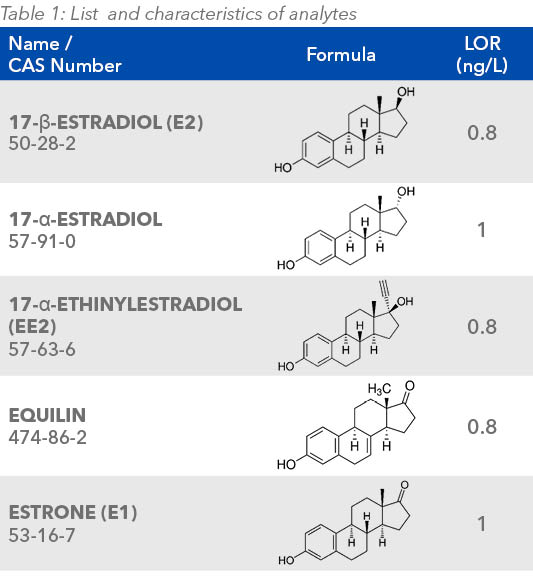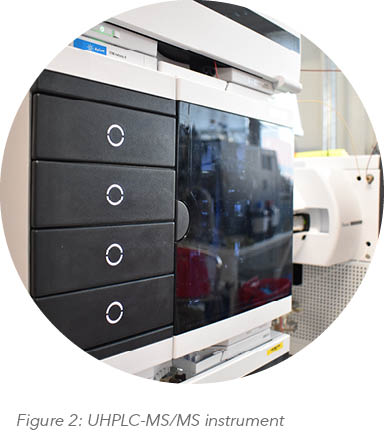The Steroid Hormones Determination in Water
Published: April 2024
Download PDF
EnviroMail_15_Europe_The Steroid Hormones Determination in Water

Water quality, especially clean drinking water, is increasingly threatened by substances released into the environment by human activity. Steroid hormones belong among the factors that contribute to the endocrine disruption in the environment. Endocrine disruption represents functional changes caused by exposure to chemical substances that can damage the organism. Steroids have garnered particular attention in recent years because they can cause various reproductive disorders even from low exposure levels. Accordingly, it is necessary to add, that their analysis is very challenging because of the very low detection limits and the selectivity required for their reliable determination.
Micropollutans in the Environment
The term micropollutants is used for harmful anthropogenic substances that occur in low concentrations (units to hundreds μg/L). The micropollutants are found across all the components of the environment, air, water, and soil. The content of micropollutants in the environment is often very low (units μg or even ng), however, the problem is the fact that even in these trace amounts they can have an undesirable effect on living organisms. Micropollutants most often enter the water from plant protection products in agriculture, but also from medicines, veterinary pharmaceuticals, and from personal care products (PCPs).
Micropollutants get into nature, where they can disturb the aquatic ecosystem. Scientific studies stated that some aquatic animals can change their behaviour under the influence of anthropogenic pollutants, and that they may have a negative effect on their reproduction. Among the most frequently occurring micropollutants are pesticide residues and their metabolites, as well as drugs. In recent years, public attention has been focused on per- and polyfluorinated alkyl compounds (PFAS) or microplastics. Steroid hormones are a relatively new topic in water monitoring, and simultaneously the newly monitored analytes.
Sources of Steroid Hormones
Steroid hormones affect the function of many tissues, especially the reproductive system. They also play an important role in the central nervous system or maintenance of bone quality.
17β-estradiol (E2), which plays a central role in the control of sexual behaviour and the reproductive
system, is probably the most famous representative of this group. 17β-estradiol is metabolically oxidized to estrone (E1) and further transformed to estriol (E3). Wellknown synthetic estrogen, 17α-ethinyl estradiol (EE2), with the strong estrogenic activity, is used in almost all contraceptive pills, as well as other medicaments, e. g. in Alzheimer's disease or to alleviate difficulties in menopause.
The soluble derivatives of hormones, which are formed during metabolism, facilitate their excretion within the urine. Therefore, human urine is considered as the main source of 17α-ethinyl estradiol in wastewater, however, estradiols also enter the environment from livestock farming, where hormones are used to treat certain diseases or to improve productivity. Active free forms of estrogens are insufficiently captured by wastewater treatment plants and pass on further into surface water. Subsequently, they can contaminate groundwater and sources of drinking water, whereby they can affect the human health.
Legislation
In view of the continuous development in this area, the World Health Organization (WHO) adopts many recommendations, which are subsequently reflected to the European and/or particular national legislation.
The control of the quality of water intended for human consumption falls under the DIRECTIVE (EU)
2020/2184 OF THE EUROPEAN PARLIAMENT AND OF THE COUNCIL. In this document, it is stated that the WHO recommended three representative endocrine-disrupting compounds (including 17β-estradiol) as benchmarks for assessing the presence of endocrine-disrupting compounds and the effectiveness of treatments where necessary. The level for 17β-estradiol was set to 1 ng/L
Methodology of Determination
Major advances in the instrumental analytical chemistry have enabled very sensitive analysis of steroid hormones in water samples. However, even with the use of the most modern analytical instruments, a complex and time-consuming sample preparation is required before analysis.
In ALS Laboratories, we have developed a procedure for the determination of the most important steroid hormones in water samples, as follows:
• 17β-estradiol (E2)
• 17α-estradiol
• 17α-ethinylestradiol (EE2)
• equilin
• estrone (E1)
Our method is based on US Environmental Protection Agency (US EPA) method No. 539 (Determination of hormones in drinking water using LC-ESI-MS/MS). This method involves sample preparation by off-line SPE and subsequent analysis by ultra-performance liquid chromatography with tandem mass spectrometry (UHPLC–MS/MS).

Sample Preparation and Analysis

Because of the legislatively required low limits (1 ng/L), it is necessary to concentrate the samples
up to 1000 times. A pre-concentration technique, solid phase extraction (SPE) is used for this purpose. SPE is a technique where the analytes from the sample are captured on a suitably chosen sorbent, and subsequently washed out into a small volume with an appropriate solvent. This enables a high degree of concentration. After the sample preparation, the analytical determination using UHPLC–MS/MS is performed.
We are currently able to analyse five steroid hormones in drinking water, tap water, bottled water and surface water samples. For the analysis of hormones in water, the minimum volume of water sample is 250 mL; samples must be collected into a dark glass bottle.
Resources
- EPA Method 539: Determination of hormones in drinking water by solid phase extraction (SPE) and liquid chromatography electrospray ionization tandem mass spectrometry (LC-ESI-MS/MS).
- K. Goeury et al. Assessment of automated off-line solid phase extraction LC-MS/MS to monitor EPA priority endocrine disruptors in tap water, surface water, and wastewater: Talanta. 2022 https://doi.org./10.1016/j.talanta.2022.123216
- S. Molnár, G. Kulcsár, P. Perjési. Determination of steroid hormones in water samples by liquid chromatography electrospray ionization mass spectrometry using parallel reaction monitoring: Microchemical Journal. 2022 https://doi.org/10.1016/j.microc.2021.107105


